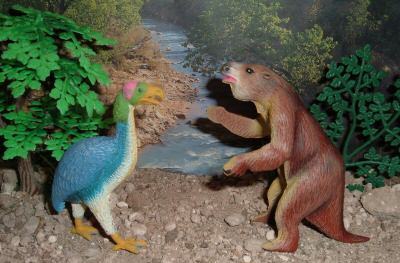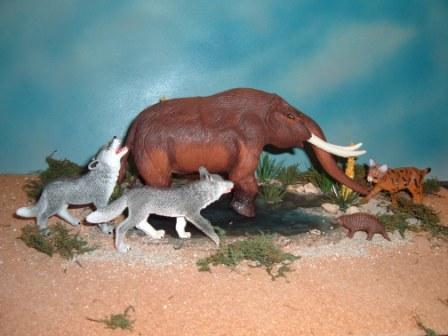North America in the Pleistocene
North America once hosted a much more varied fauna than what the early European colonists found. In retrospect it seems obvious that many ecological niches were vacant. The tundra on North America was much like that of Europe and Asia. Further south in the more temperate climates a unique mix of animals from South America and Eurasia existed. Mammoths, Mastodons, Lions , Cheetahs, Camels and horses like you find in the old world. Sloths, Glyptodonts, giant predatory birds, armadillos, Dire Wolves and Saber tooth tigers from South America. Updated 022612
 The ancestors of dire wolves Canis dirus went south over the land bridge to later return as specialized bone crushing predators. Amaradillos and Pampatheres came north also.
The ancestors of dire wolves Canis dirus went south over the land bridge to later return as specialized bone crushing predators. Amaradillos and Pampatheres came north also.
 |
 |
Smilodon was found in both North and South America. Its larger saber teeth allowed it to hunt and kill large thick skinned prey. |
The giant ground sloth Eremotherium occurred in North America during the Pleistocene restricted to the area that is now Florida. It was closely related to Megatherium the giant sloth of South America |
 |
 |
| The European Cave Lion Panthera leo atrox was a top predator. It is not clear if it was actually a lion or tiger. There were two bison the ancestor of the modern American buffalo the Steppe Wisent Bison priscus and the giant long horned Bison nascornis. Bears diversified cave bears, short faced bears and grizzles. There were lesser cats and wolves. | Doedicurus is a well-known Glyptodont. It had a bony club covered with spikes at the end of a stiff shaft on its tail. Glyptodonts first appeared during the Early Miocene Epoch. They developed from armadillo-like mammals with bony plates of "armour" which were arranged in rings. They were herbivores (plant eaters), and reached the peak of their success as grazers on the grasslands of South America the Pliocene Epoch and Pleistocene Epoch |
 The American mastodon (Mammut americanum) was a large, elephant-like herbivore. It ranged in height from approximately 7 feet (2.1 meters) in females, to nearly 10 feet (3 meters) in males; an adult mastodon could weigh as much as 6 tons (5400 kilograms). Its head was equipped with a flexible trunk, small ears, and tusks. The tusks grew straight forward, nearly parallel to one another, and curved slightly upward. Unlike modern elephants and extinct mammoths, the mastodon had cuspate molar teeth. The name "mastodon" is a Greek derivative—mastos, "breast," and odon(t), "tooth"—that references the animal's teeth, which have crowns consisting of distinct rounded cusps.t was mostly adapted to conifer forests and marsh. It fed on plants (conifer twigs, swamp plants, larch, spruce, pine, grass, mosses, etc.) and used its tusks to break branches.
The American mastodon (Mammut americanum) was a large, elephant-like herbivore. It ranged in height from approximately 7 feet (2.1 meters) in females, to nearly 10 feet (3 meters) in males; an adult mastodon could weigh as much as 6 tons (5400 kilograms). Its head was equipped with a flexible trunk, small ears, and tusks. The tusks grew straight forward, nearly parallel to one another, and curved slightly upward. Unlike modern elephants and extinct mammoths, the mastodon had cuspate molar teeth. The name "mastodon" is a Greek derivative—mastos, "breast," and odon(t), "tooth"—that references the animal's teeth, which have crowns consisting of distinct rounded cusps.t was mostly adapted to conifer forests and marsh. It fed on plants (conifer twigs, swamp plants, larch, spruce, pine, grass, mosses, etc.) and used its tusks to break branches.
